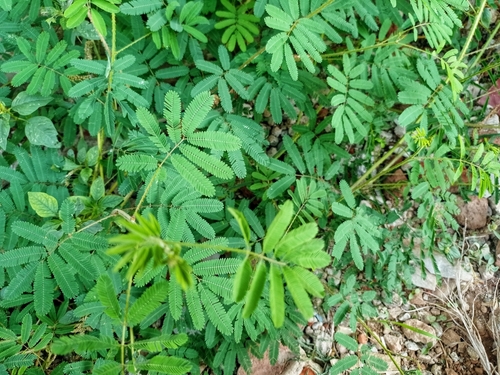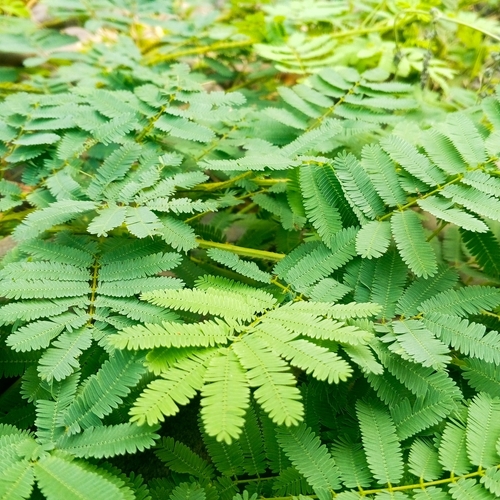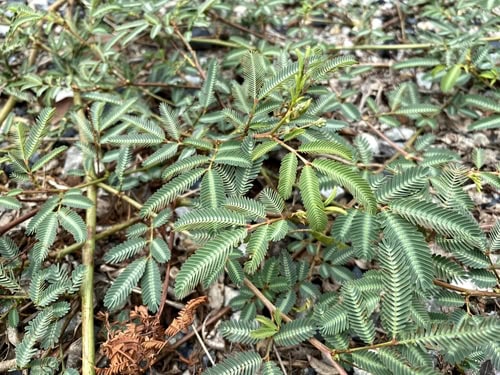The sensitive plant, also known as Mimosa pudica, is a fascinating plant that reacts to touch and light. Its leaves fold inwards and droop when touched, making it a popular houseplant.
However, if you notice your sensitive plant dying, it can be a cause for concern. There are several reasons why a sensitive plant may be dying, and it’s important to understand them to revive the plant and prevent it from happening again.
Understanding the sensitive plant is the first step in identifying why it may be dying. The sensitive plant is a tropical plant that requires a warm and humid environment to thrive.
It’s a delicate plant that can be easily stressed by changes in its environment, such as overwatering, underwatering, or exposure to extreme temperatures. Additionally, the sensitive plant is susceptible to pests and diseases that can cause it to wilt and die.
Common reasons for a dying sensitive plant include overwatering, underwatering, exposure to extreme temperatures, and pests or diseases. Overwatering can cause the roots to rot, while underwatering can cause the plant to wilt and die.
Exposure to extreme temperatures, such as cold drafts or direct sunlight, can also stress the plant and cause it to die. Pests and diseases, such as spider mites and fungal infections, can also cause the plant to wilt and die.
Key Takeaways
- The sensitive plant is a delicate tropical plant that requires a warm and humid environment to thrive.
- Common reasons for a dying sensitive plant include overwatering, underwatering, exposure to extreme temperatures, and pests or diseases.
- To revive a dying sensitive plant, it’s important to identify the cause and take corrective action, such as adjusting watering habits, providing proper lighting and temperature, and treating pests and diseases promptly.
Also read:
Understanding the Sensitive Plant

The sensitive plant, also known as Mimosa pudica, is a fascinating plant that is well-known for its unique characteristic of being sensitive to touch. This plant belongs to the Fabaceae family and is native to Central and South America. The sensitive plant is a perennial plant that is usually grown as an annual in cooler climates.
The sensitive plant has fern-like leaves that are made up of small leaflets. These leaflets fold up and the entire leaf droops when touched or disturbed. This motion is caused by a change in turgor pressure within the cells of the plant.
The turgor pressure is the amount of water pressure in the cell pushing up against the cell wall. When the plant is touched, the turgor pressure in the cells is lost, causing the leaflets to droop.
The sensitive plant is a dainty plant that is quite delicate and requires special care. It has tiny hairs on its leaves, which are sensitive to touch. The fan-like motion of the leaves is a defense mechanism that helps the plant to deter herbivores and insects from eating it.
To care for a sensitive plant, it is important to keep the soil moist but not waterlogged. Overwatering can cause the plant to die. The plant also requires high humidity to look its best. It can be grown in a pot and kept indoors or outdoors in a warm, sunny location.
Why Is My Sensitive Plant Dying – 6 Common Problems
A sensitive plant can be a beautiful addition to any houseplant collection. However, it can be disheartening to see it slowly wither away. Here are some common reasons why a sensitive plant might be dying and how to fix them.
1. Underwatering and Overwatering
One of the most common reasons for a dying sensitive plant is incorrect watering. Underwatering can cause the leaves to wilt, turn yellow, and eventually fall off. On the other hand, overwatering can lead to root rot, which can cause the plant to die.
To avoid underwatering or overwatering, make sure to water the plant when the top inch of soil is dry to the touch. Use a moisture meter to ensure that the soil is consistently moist but not waterlogged. Additionally, make sure that the pot has proper drainage to prevent water from accumulating at the bottom.
2. Inadequate Light

Sensitive plants require bright but indirect light. If the plant is not receiving enough light, the leaves may start to droop and fall off. On the other hand, if the plant is exposed to direct sunlight, the leaves may become scorched and turn brown.
To ensure that the plant is receiving adequate light, place it near an east-facing window or under a full-spectrum fluorescent grow light. Avoid placing it in direct sunlight or in a drafty area.
3. Improper Temperature
Sensitive plants prefer a temperature range between 65-75°F. If the temperature is too hot or too cold, the plant may start to wilt or drop leaves. Drafts or sudden temperature changes can also stress the plant and cause it to die.
To ensure that the plant is in a suitable environment, avoid placing it near a drafty area or in a greenhouse. Keep the plant away from air conditioning or heating vents.
4. Pest Infestation
Pests such as spider mites, mealybugs, and aphids can infest a sensitive plant and cause it to die. These insects can suck the sap from the leaves and cause them to turn yellow and fall off. Fungal infections such as powdery mildew can also affect the plant’s health.
To prevent pest infestations, regularly inspect the plant for signs of insects or fungal growth. If an infestation is detected, remove the affected leaves and treat the plant with an insecticide or fungicide.
5. Poor Soil and Drainage
Sensitive plants require well-draining soil to prevent water from accumulating around the roots. If the soil is nutrient-poor or does not drain properly, the plant may start to wilt or turn yellow.
To ensure that the plant is in suitable soil, use a pot with proper drainage and fill it with a mixture of peat moss, perlite, and loamy soil. Additionally, fertilize the plant once a month during the growing season with a high-potassium liquid fertilizer diluted to about half strength with water.
6. Incorrect Fertilization
Overfertilization or underfertilization can also cause a sensitive plant to die. Too much fertilizer can burn the roots and cause the plant to wilt, while too little fertilizer can cause the leaves to turn yellow and fall off.
To ensure that the plant is receiving adequate nutrients, fertilize it once a month during the growing season with a high-potassium liquid fertilizer diluted to about half strength with water. Avoid fertilizing the plant during the dormant season.
Signs of a Distressed Sensitive Plant
Sensitive plants are known for their unique ability to fold their leaves when touched or exposed to vibrations. However, when a sensitive plant starts to show signs of distress, it can be a cause for concern. Here are some signs to look out for:
Leaves and Foliage

- Yellowing leaves: If the older leaves of your sensitive plant are turning yellow, it’s a natural process of shedding old leaves to make way for new growth. However, if the yellowing is widespread and accompanied by wilting, it could be a sign of overwatering or root rot.
- Brown leaves: Brown leaves on a sensitive plant can indicate underwatering, overwatering, or too much direct sunlight. If the brown spots are isolated, you can prune the affected leaves. However, if the brown spots are widespread, it may be best to repot the plant.
- Holes or dry leaves: If your sensitive plant’s leaves have holes or are dry to the touch, it could be a sign of insect infestation. Check the plant for pests and treat accordingly.
- Fern-like leaves: If your sensitive plant’s leaves are turning fern-like, it could be a sign of too much direct sunlight. Move the plant to a shadier spot.
Roots and Stem
- Bone dry soil: If the soil around your sensitive plant is bone dry, it’s a sign that the plant needs watering. However, be careful not to overwater the plant as it can lead to root rot.
- Dead stems: If your sensitive plant’s stems are turning brown and brittle, it could be a sign of underwatering or root rot. Check the soil moisture level and adjust watering accordingly.
- Root rot: Root rot is a fungal disease that affects the roots of plants, causing them to rot and die. If your sensitive plant is showing signs of root rot, such as wilting, yellowing leaves, and a foul odor, it’s best to repot the plant and remove any affected roots.
Reviving a Dying Sensitive Plant
When a sensitive plant is dying, it is important to act quickly to revive it. Here are some steps to take to help your sensitive plant recover:
1. Check the Care and Environment
The first step is to check the care and environment of the plant. Sensitive plants are delicate and require specific conditions to thrive. Make sure the plant is getting the right amount of light, water, and fertilizer.
Also, check the humidity levels and temperature of the room. If any of these factors are off, it can cause stress to the plant and lead to its demise.
2. Watering

Overwatering is a common cause of a sensitive plant’s death. Make sure the soil is moist but not waterlogged. Wait until the top 2 inches of soil are dry before watering the plant. Use lukewarm water and always allow the excess to drain out of the bottom of the pot. This will prevent the roots from rotting and will help the plant to recover.
3. Repotting
If the plant is root-bound, it may need to be repotted. This will give the roots more room to grow and allow the plant to absorb more nutrients. Use a well-draining soil mixture and a pot that is slightly larger than the current one.
4. Propagation
If the plant is beyond saving, you can propagate it to create new plants. This can be done by taking cuttings from the plant and rooting them in water or soil. Sensitive plants are easy to propagate, and this can be a great way to save a dying plant and create new ones to enjoy.
5. Defense Mechanism
It is important to note that a sensitive plant’s leaves will naturally close when touched or disturbed. This is a defense mechanism and does not necessarily mean that the plant is dying. However, if the plant’s leaves are closing and not reopening, it may be a sign of stress or illness.
By taking these steps, you can help revive a dying sensitive plant and bring it back to health. Pay attention to the plant’s needs and make adjustments to the environment and care as necessary. With proper care and attention, your sensitive plant can thrive and produce beautiful blooms.
Preventive Measures for a Healthy Sensitive Plant
Taking preventive measures can help keep your sensitive plant healthy and thriving. Here are some tips to follow:
1. Care and Growth
Sensitive plants require bright, indirect light and consistently moist soil. Water your plant when 50% of the soil volume is dry, and discard any water that has accumulated in the saucer.
Reduce watering in the winter for indoor sensitive plants. These plants require high humidity to look their best, so consider placing a humidifier near your plant or misting it regularly.
2. Environment

Sensitive plants are not just sensitive to touch, but also to their environment. Keep temperatures indoors or outdoors between 65 and 75 degrees Fahrenheit for best results. Avoid exposing your plant to drafts or sudden temperature changes, as they can cause stress and damage to the plant.
3. Pests and Diseases
Sensitive plants can be prone to spider mites and mealybugs. To prevent infestations, regularly inspect your plant for tell-tale signs of pests, such as webbing or white cottony masses. If you spot any pests, isolate the plant and treat it with an insecticidal soap or oil.
Powdery mildew and aphids can also affect sensitive plants. To prevent these diseases, avoid overwatering and keep the plant in a well-ventilated area. If you notice any signs of disease, treat the plant with a fungicide or insecticide.
4. Fertilizing and Repotting
Sensitive plants do not require frequent fertilizing. Use a diluted high-potassium liquid fertilizer every two weeks during the growing season. Repot your plant into a larger container with fresh potting soil if you notice that the roots are becoming root-bound or the plant is not growing.
5. Propagation
Sensitive plants can be propagated from seeds or cuttings. To propagate from seeds, sow them in a pot filled with a mix of peat moss and perlite. Keep the soil consistently moist and the pot in a warm, bright location.
To propagate from cuttings, take a cutting from a healthy plant and place it in a pot filled with moist soil. Keep the soil consistently moist and the pot in a warm, bright location.
By following these preventive measures, you can help keep your sensitive plant healthy and thriving.
Frequently Asked Questions
Is it bad to touch a sensitive plant?
No, it is not bad to touch a sensitive plant. In fact, it is quite fascinating to see the plant’s leaves fold in response to touch. However, excessive touching can cause stress to the plant and lead to leaf drop. So, it is best to avoid touching the plant unnecessarily.
How to save a dying mimosa tree?
If your mimosa tree is dying, it could be due to a variety of reasons such as overwatering, underwatering, pests, or disease. To save a dying mimosa tree, it is important to identify the root cause of the problem.
Check the soil moisture, inspect the leaves for pests or disease, and make sure the plant is getting enough sunlight. Adjust the watering schedule and treat any pests or disease accordingly.
Sensitive plant leaves falling off?
If the leaves of your sensitive plant are falling off, it could be due to overwatering, underwatering, or nutrient deficiency. Check the soil moisture and adjust the watering schedule accordingly. Also, make sure the plant is getting enough nutrients by fertilizing it regularly.
How long do sensitive plants live indoors?
Sensitive plants can live indoors for several years if they are provided with the right care. However, their lifespan can be affected by various factors such as light, temperature, and humidity. With proper care, a sensitive plant can live up to 5 years indoors.
Sensitive plant care indoors?
To care for a sensitive plant indoors, it is important to provide it with bright, indirect light, well-draining soil, and regular watering. The plant also benefits from occasional fertilization and pruning to promote healthy growth.
Do sensitive plants like to be misted?
Sensitive plants do not require misting, but they do benefit from a humid environment. To increase humidity around the plant, you can place a tray of water near it or use a humidifier. Avoid misting the leaves directly as it can cause damage to the plant.

Hey, I’m Lisa and I’ve been an avid gardener for over 30 years. I love writing, talking and living in the garden! Feel free to connect with me on my socials below


